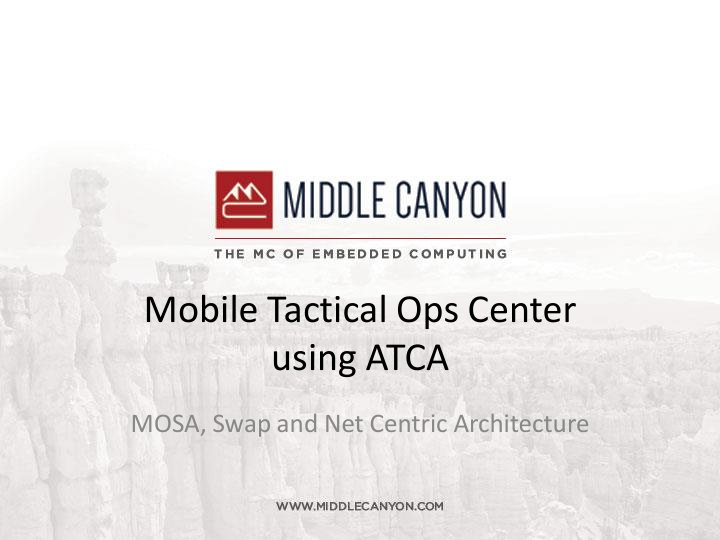



Mobile Tactical Ops Center using ATCA MOSA, Swap and Net Centric Architecture
DoD - Net Centric Architecture Data Producers Data Consumers Need Network access platforms to collect and analyze intelligence Ethernet Call H.323 Client H.323 Manager Wireless IP Phone (softphone) Phone
MTOC Requirements Must support Virtualization Application FT, Rapid self repair Run collaborative “grid” applications Command, control and mission logistics Exchange, file shares, storage Unified messaging (email, voice mail, sms etc.) Field deployment form factors Mobility: Smaller, lighter is better (SWaP) Mounted form factor (Ship, airframe, vehicle) Adapt to Physical restrictions; Moderately Rugged
Mobile Tactical Ops Center RCP attributes 1 Platform Combines Network, Compute, Storage Plugs into existing Intelligence grid (10/40Gb) Integrated high speed NAS/SAN Scalable platforms 2, 6 or 14 slot Max: 120 cores Max: 2000GB memory Max: 12TB raw disk Stack platforms together “Air Gap” Secure Networks
MTOC and SWaP (Space, Weight and Power) Military Definition of two man carry Absolute maximum: 160 Lbs 10K watt Diesel generator 144 gallons = 2000 watts x 30 days
The Cost of Power Pentagon: Forces use 12.6M gallons/day Military fuel: Cost/gallon* $13 forward-deployed location (peacetime) $42 in flight from a refueling airplane $100- 600 hostile areas, “in theater” delivery $400- if shipped via army helicopters Strategic to minimize Watts consumed *http://www.nationaldefensemagazine.org/archive/2010/April/Pages/HowMuchforaGallonofGas.aspx
MTOC 6 slot Version 2-Man Carry, 6 slot ~130 lbs 922 Watts – Measured 144 gallons fuel = 60 Days.
What is ATCA? Advanced Telecommunications computer Architecture Open specification for blade architecture Author: PCI industrial computing manufacturers group www.PICMG.org Goals Telco grade components, flexible topology High MTBF Visibility and manageability Scalable, High bandwidth backplane Interoperability Meet Central Office and NEBS requirement N etwork E quipment B uilding S ystem
Why ATCA? Interoperability and Community ~350 active participants Carriers, NEP's, Compute Companies, Component Suppliers, Software, etc. > 10 Chassis vendors Specification Governed by independent spec body IP contributed Backward compatibility maintained Open Sourcing Model >10 Chassis vendors Multiple switch, server, management, and I/O vendors Interoperability Workshops
SWaP Summary: MTOC vs. Rack “ATCA’s superior SWaP metrics favor the mobile and afloat military initiative” The initial lower cost for racks is not advantageous in the long term.
MTOC Ready for Deployment! Thank you.
Recommend
More recommend